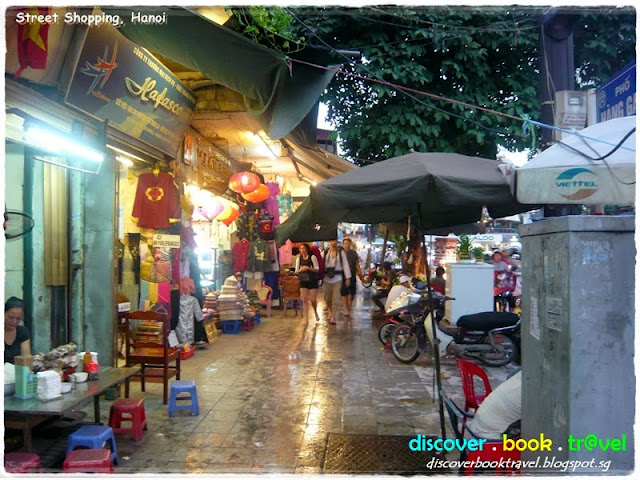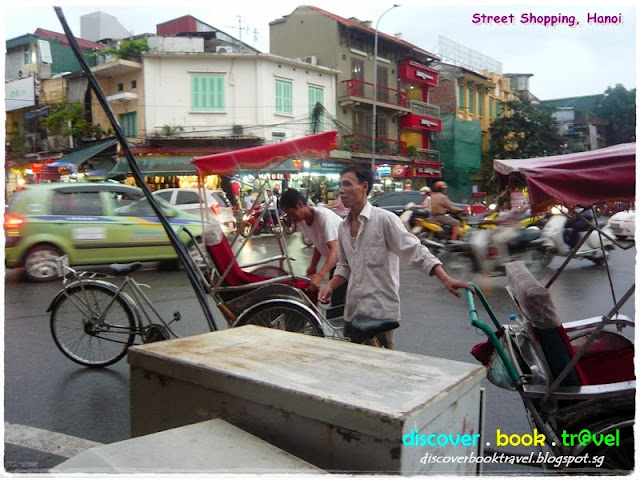Hanoi . 2013 . Aug 7 - 13
This post is part of our Hanoi 7 days 6 nights Trip Itinerary and Report. Do check out the full itinerary and our reviews here.
Shopping at the Old Quarters of Hanoi, Vietnam can be quite an unforgettable experience. The 36 streets of the Old Quarters are intricately linked and with the un-ending flow of traffic and street hawkers, it is easy to get lost in the maze of the Old Quarters. You can choose to get immersed in the local culture of the Old Quarters, or if you are looking for something specific, get a map and find the specialized street that sells that particular item. You will find that the entire street sells similar or identical stuff at different prices, so that’s where you’ll need your bargaining skills to come in.
We have compiled a list of tips for you to help you along.
Here is a list of the main streets and their specialised items.
Specialized Streets
- Bat Su for China Bowls
- Cau Go for women's accessories
- Cha Ca for roasted fish
- Hang Bac for silver or jewelleries
- Hang Buom for bamboo products, candies and wine
- Hang Can for stationery
- Hang Chinh for jars
- Hang Dau for shoes
- Hang Duong for candies and dry apricot
- Hang Gai for silk and tailored clothes
- Hang Hom for lacquerware and bamboo
- Hang Luoc for combs
- Ma May for Tour Services
- Thuoc Bac for tools
- To Tich for mixed fruits
Bargaining Tips
- Bargaining is a must with the small retail shops at the Old Quarters. We’ve had one storekeeper quote us an exorbitant price for a straw hat, only to have another one rushing out to quote us 50% lower when she sees us walking away. The same thing happened with the storekeeper selling bags. Storekeepers usually want to overcharge tourists and foreigners, but it is not difficult to bargain because the shops along the whole street are all selling identical stuff.
- Walk along the whole street to get a feel of the variety, quality and prices of things sold in each shop. Identify one shop where you can consolidate all your purchase for better bargaining power. By this time, you would already have a good feel of how much things cost.
- As a rule of thumb, always slash the asking price of the shopkeeper by 50% and negotiate from there. Some shopkeepers will ask you how much you are willing to pay, and this is where your homework comes in handy for you. Quote them a genuine price that you are willing to pay, but keep in mind that you won’t be able to go any lower if he agrees to your price. In general, the final paying price should be 20 to 40% lower than the first asking price.
- Even if the negotiation falls through, always remain polite and keep the smile on your face. If you eventually decide to walk away, do so courteously. There is always another shop for you to try your luck at.
- Try your luck early in the morning where you are the first customer. Vietnamese shop keepers are still superstitious and believe that it is not a good omen for their first customer of the day to walk away. We’ve unknowingly stumbled across this fact at Hang Gai. The shopkeeper was literally begging us to purchase something because at 12 noon on a Monday, we were the first customer in their shop! So you can imagine how much bargaining power we had.
- Some shops display a ‘fixed price’ sign, so no luck there! Avoid them as there are plenty of other market stalls and night market for you to try your bargaining skills on.
Exchanging Currencies
Most items in Hanoi are listed in Vietnam Dong (VND), although you can state your price in USD as well. Most transactions are completed with Vietnam Dong, although some shopkeepers will readily take USD.Tip: There are plenty of banks around the Old Quarters (look around the Hoan Kiem Lake area near the water puppet theatre) to exchange currencies into Vietnam Dong. These banks accept most foreign currencies. Try the money exchanger at the tourist centre at the Hoan Kiem lake as well. They offer quite favourable currencies for SGD. Another place would be the Hanoi Airport which offers much better exchange rates than the money exchangers in Singapore.
Most major restaurants and hotels accept credit cards. However, some small scale hotels, eateries and especially the shops at the Old Quarters do not accept credit cards. Therefore, it is recommended to keep the Vietnam Dong in hand for buying small souvenirs or to enjoy street fare from the street hawkers.
We hope you enjoyed reading our tips for shopping in the Old Quarters of Hanoi, Vietnam.
Have you been to Hanoi or have any tips to share? We look forward to your comments and tips! :)
This post is part of our Hanoi 7 days 6 nights Trip Itinerary and Report. Do check out the full itinerary and our reviews here.
We hope you enjoyed reading this article. To receive notifications on updates, subscribe to our blog via RSS feed and email.
Like us on Facebook @ Discover. Book . Travel and follow us on Twitter @Discoverbooktra!
Do check out our Flickr photos & Youtube videos too!
 RSS Feed
RSS Feed







0 comments:
Post a Comment